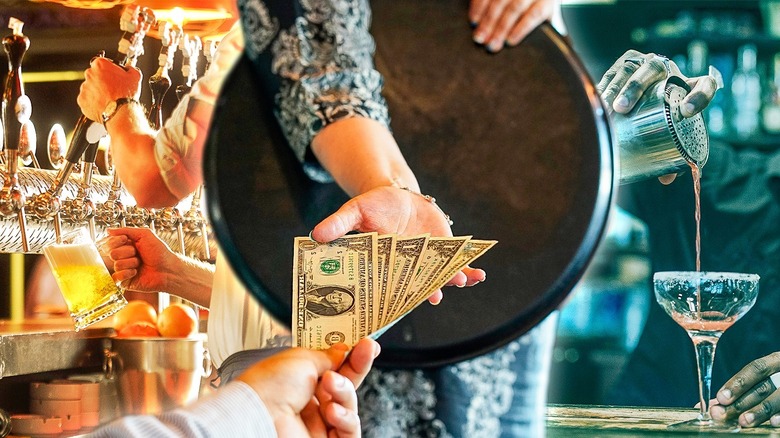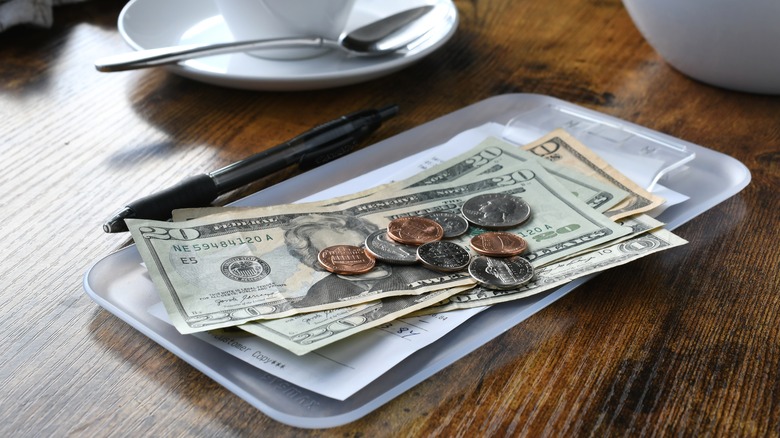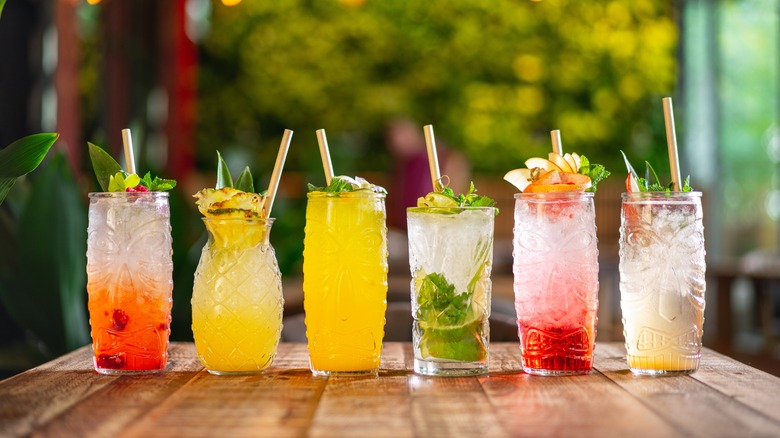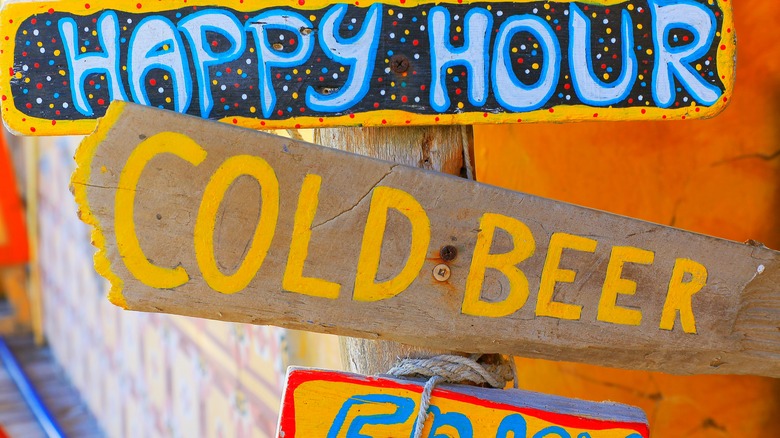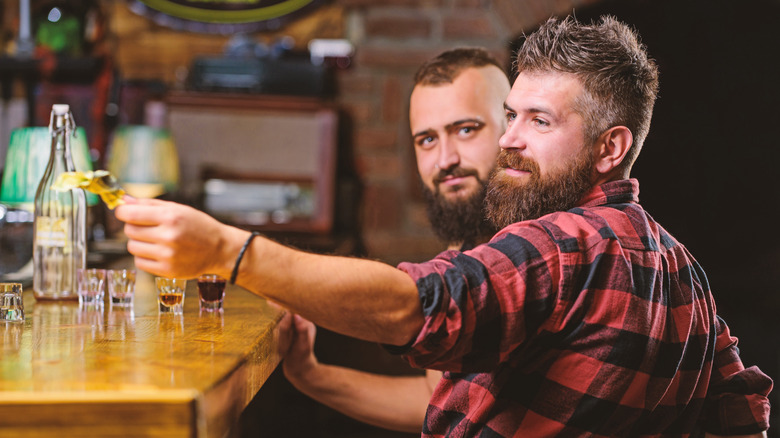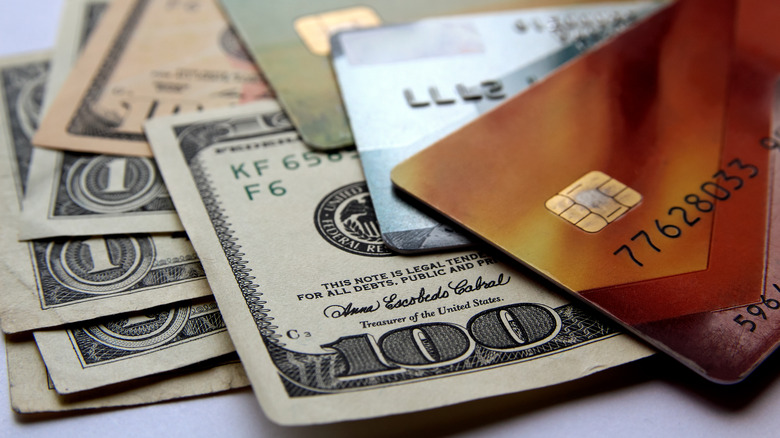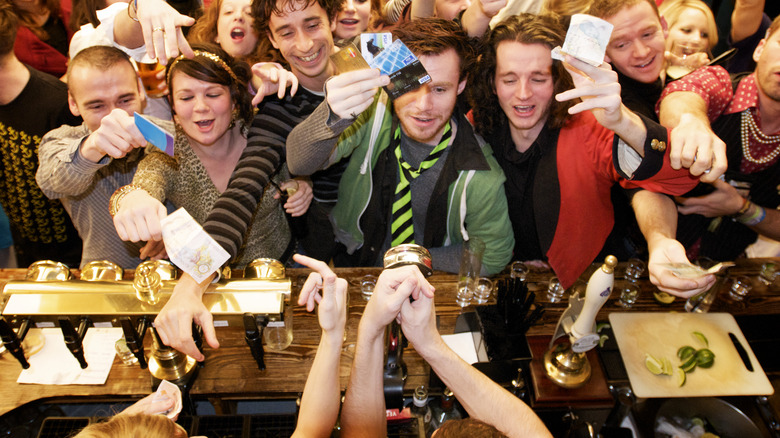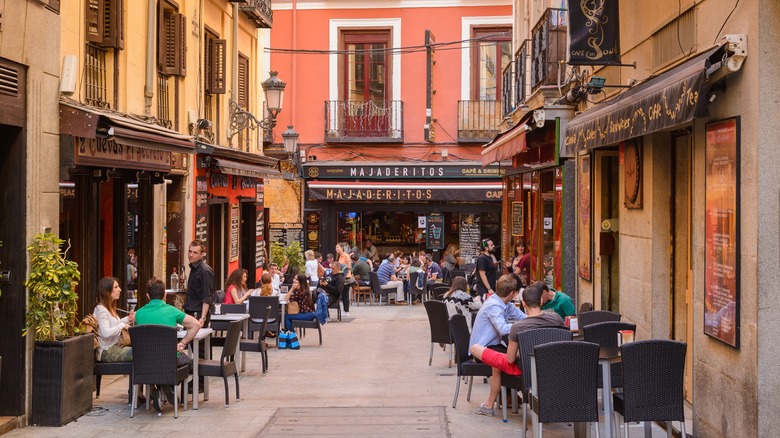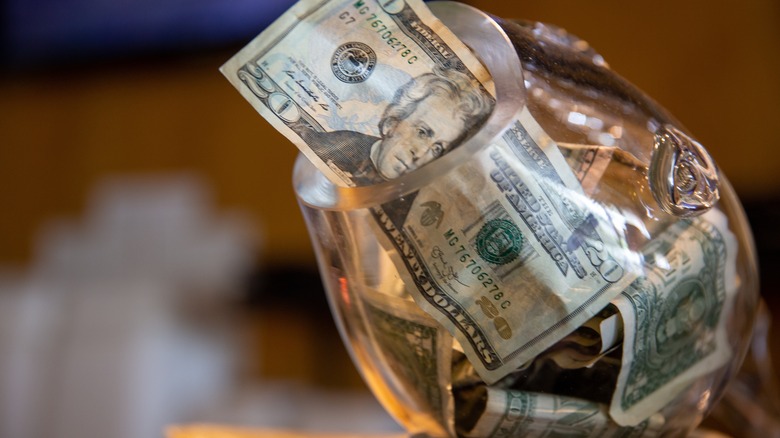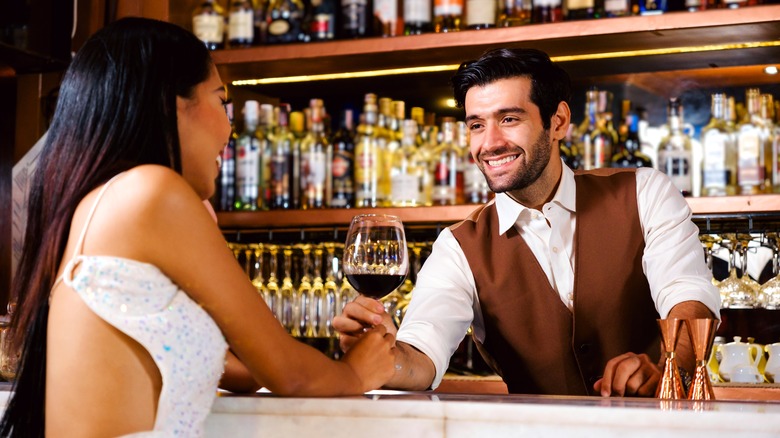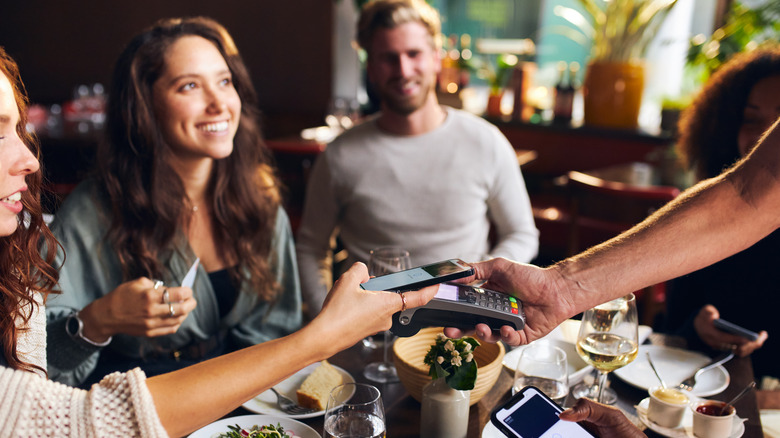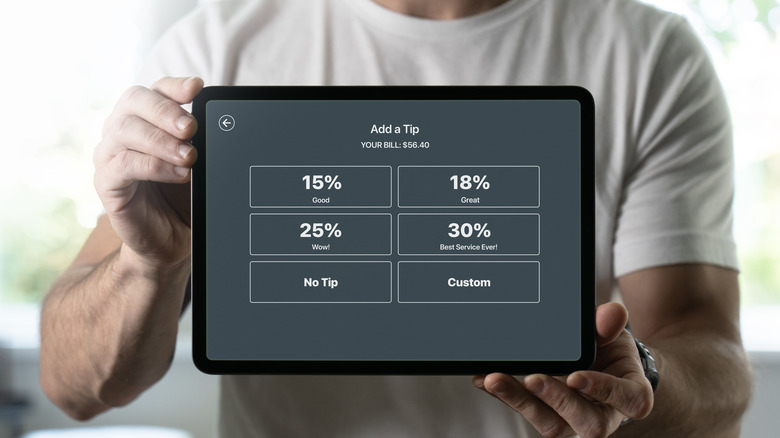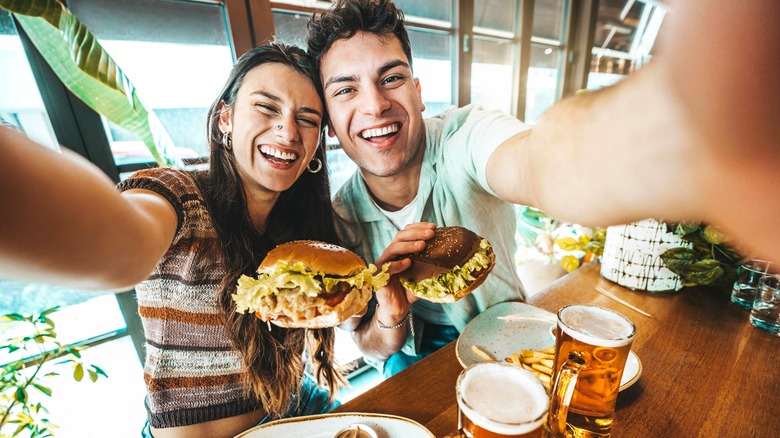12 Things To Keep In Mind When Tipping At A Bar
Scroll the comments section of any article about tipping, and you'll be immediately swept away by an avalanche of strong opinions: People who've never worked in the service industry telling service staff to "get real jobs" if they don't want to rely on tips, bartenders and servers rebounding with their (often impressive) earnings, and the odd European or Aussie without the foggiest idea how tipping works in the United States. It's almost always a chaotic maelstrom of differing opinions. As commenters shout over one another in the metaverse, the question remains — in a time of economic strain and tip fatigue, how much should one tip?
The answer varies depending on the setting. Generally speaking, in restaurants and bars in the United States, a 20% tip is considered the standard assuming you received good service — the only time it may be acceptable to leave a bad tip is if you've had a horrendous experience from start to finish, with no one attempting to rectify it. There are, however, some differences when it comes to tipping at restaurants versus bars. Bartenders act as sort of a kitchen of their own — they're not simply taking your order and sending it back to the back-of-house staff; they are pouring beers and shaking up cocktails in front of a live audience every night as well as performing a laundry list of tasks unseen by most bar patrons. Not sure how much to tip at bars? Depending on the situation, the answer might be a bit more complex than the standard 20%, so we've put together a guide to help you out.
20% is standard
Did you know bartenders and servers in some states are paid an hourly wage as low as $2.13 per hour? In many states, service staff rarely receive an actual paycheck because nearly all their hourly income goes to taxes, so tips keep roofs over their heads and food on their tables. Whether you agree or disagree with the way most restaurant owners run their businesses, the fact of the matter is that a 20% gratuity is the generally suggested amount in the United States at the time of writing. If the service is just okay, but nothing actually went wrong, 15% may be acceptable.
Of course, many customers leave tips significantly lower or higher than the 20% standard. According to a 2023 report conducted by Toast, most people actually tip about 16.9% of the bill in quick-service restaurants, closer to the 15% that was the socially acceptable "great service" number years ago, but not far off from 20. "Stiffing," industry speak for not leaving a tip at all, is incredibly rude and may result in your server or bartender actually paying for a portion of your bill — lots of bars and restaurants require front-of-house staff to "tip out" a portion of their earnings to food runners, bussers, or even back-of-house. If you had a stellar experience with your bartender, by all means, leave even more than 20%. Your bartender is guaranteed to appreciate it (and may be more likely to remember you the next time you come in).
Tip more on complex orders
Not so long ago, the rule of thumb for tipping at bars was "a dollar a drink." Today, when a domestic draft beer can easily cost $8 to $10 and a craft cocktail upwards of $15 at an upscale bar, the rules are a little different. The 20% tip guideline can be frustrating for those who tend to stick to beer and wine — all the bartender has to do is pour a draft or crack open a bottle, right? It may seem that way on the surface, but bartenders have tons of invisible labor behind the scenes and often juggle multiple customers at once. Unless your bartender is openly rude or hostile, be a good sport and leave at least $2 on that $10 bill, even if it's just a draft of your favorite IPA.
When it comes to tipping on beer versus cocktails, the 20% rule still stands, especially if your order is something simple like a Jack and Coke, gin and tonic, or vodka soda. In the case of craft cocktails, however, tipping a little extra (or a lot, if you please) is a class move that'll surely win you points with the bartender. Many bars offer complicated cocktails that require myriad special ingredients and take a hot minute to make. Do your bartender a solid and slip them a few extra bucks on that Ramos gin fizz (if you know, you know) or lavender lemonade mojito with house-made elderberry syrup and edible flowers.
Give a little extra if you're getting a deal
Happy hours and drink specials offer a great way to try out new restaurants and bars or revisit your old favorites while saving a little off the top. Bars and restaurants often find that happy hours increase patronage during slower hours (most commonly late afternoons and late nights) — offering deals like 2-for-1 drink specials or discounting certain menu items is a great way to entice consumers who may not otherwise visit the business. Some bars run nightly specials such as a wine Wednesday or deals for certain holidays or special events, too.
If you're getting a discount on your final check, it's proper etiquette to leave a tip equivalent to what 20% of the final bill would have been without the discount. For example, if your favorite Tex Mex joint runs a 2-for-1 special on $10 margaritas, you're saving a whole $10 per round! Tipping $4 (which is 20% of the original bill price of $20) rather than $2 (20% of $10) really won't cost you much in the scheme of things. Bear in mind that the bartender is still doing the same amount of work to make the drinks, and you're saving money by taking advantage of discounted items. Tipping a few extra dollars is a great way to show the bartender some love without breaking the bank.
Good service deserves a good tip
We get it: There are some people who "don't believe in tipping" or who intentionally don't tip out of spite, but the fact is, the majority of Americans tip at least something when they visit a restaurant or bar. Because bartenders rely on tips for a living, failing to leave even a dollar is not cool, unless the service is truly god-awful — as in, bartender-spits-in-your-face awful. Remember, there are tons of factors that can affect the level of service you receive, many of which are not visible to the average customer.
Bottom line? If the bartender appears to be trying their best, leave at least 20%. Everyone has bad days, but an off night won't affect a lawyer's or teacher's salary the way it can impact a service professional. Sometimes bartenders make mistakes because they are human. Was the mistake rectified? Tip 20%. Sometimes the bar is packed, and it takes longer to get your drink. Did the bartender still make your drink (and hopefully, apologize for the delay)? Tip 20%. On the flip side, if your bartender went above and beyond to ensure you had a great experience, tip 25%, or even more if you please.
Cash and credit both have pros and cons
Bars and restaurants have widely varying policies for giving bartenders and servers their tips. Some bars implement a "tip pool," with employees splitting all earned tips. Many bars allow bartenders to keep the tips they earn individually. While some bars "cash out" (give bartenders the cash amount of their total cash and credit card tips) every night, others run payroll and employees receive all credit card tips on a weekly or bi-weekly statement.
Customers aren't expected to know how each business doles out employees' tips, but know there are differences if you tip in cash or on a credit card. Often, a cash tip allows the bartender to keep the full amount of the tip without having it taxed (unless the employee declares it), and if the bar gives its employees their tips via regular paychecks, the bartender may be able to walk with that extra cash at the end of the night. On the flip side, not everyone carries cash, and there are pros and cons to tipping on a card, too. Since card tips are visible to the bar, a portion of credit card tips may be allocated to card fees or other restaurant operating charges. However, some bartenders are happy to wait for their credit card tips on a weekly or bi-weekly paycheck. Most restaurant and bar employees seem to agree that cash is king, but at the end of the day, tips in either form are welcome.
Wait time shouldn't affect your tip
When a bar is brimming with activity and packed with customers, it's most likely going to take the bartenders a little longer to take orders, shake up cocktails, pour beers, and close customers out. Good bartenders can work at light speed and keep customers as happy as possible, but they're only human. Waiting a little longer for your drink can feel frustrating, and bartenders understand that. Assuming the bartender is moving quickly, being friendly, and generally doing their job, a long wait time for a drink is not a reason to dock their tip — and if you truly can't wait, walk out and find a calmer spot.
If the place seems slow and your drink is still taking forever, take a look around and consider what might be affecting your wait time. Is there only one person making drinks? Did the bachelorette party to your left order six different craft cocktails? Is the slow bar attached to a busy restaurant (bartenders often make drinks for the entire restaurant in addition to their bar patrons)? Many factors affect a bartender's ability to whip up drinks quickly, and a little understanding goes a long way.
Tipping is different outside the United States
These best practices apply primarily to tipping in bars in the United States, where friendly and prompt service generally warrants a sizable tip. However, if you're traveling outside the U.S., take the time to learn the customs of the place you're visiting. In most other countries, servers and bartenders are paid a higher hourly rate than U.S. service staff and do not rely solely on tips to pay their bills. In some countries, especially those in Europe, small tips for above-and-beyond service are seen as a nice gesture but are not at all expected.
However, in certain places, tipping is not part of the dining culture at all. For example, tipping in Japan is considered rude and unwarranted in most situations, whether you're enjoying martinis at a Michelin-starred restaurant in Tokyo or drinking sake at a dive bar in Kyoto. It might feel bizarre or even uncomfortable to well-meaning Americans, but the Japanese generally consider tipping disrespectful and will go out of their way to return any money left on the table. Every culture is different, and travelers should make a point of learning the local do's and don't's of the countries they're visiting.
Tips should be monetary
Anyone who's done hard time in the service industry can tell you about instances when their patrons have left something besides a cash or credit card tip. The lore of the Sunday church crowd leaving prayer cards printed on slips that look like cash is rampant amongst servers and bartenders. Customers have been known to leave their bartenders everything from gift cards to handmade items to illicit drugs in lieu of tips, and while these "gifts" may or may not be appreciated by staff, they're not going to help the bartender pay their rent.
It may seem like a nice gesture to leave a Starbucks or spa gift card for the bartender instead of a tip if it's just burning up space in your wallet, but this isn't always the case, and depending on the gift, the bartender may not even want or be able to use it — for example, a gift card to a steakhouse certainly won't be of much use to a vegan bartender. If you absolutely insist on leaving behind a prayer card, gift certificate, or anything else for your bartender, leave it along with — not instead of — a 20% cash or credit card tip.
Do you expect to return?
Bartenders have long memories and an uncanny ability to recall both great and not-so-great tippers. It may not sound fair, but bartenders tend to prioritize customers they know will tip well over those they know do not, especially if stiffing or leaving poor tips is a repeated behavior. Good tippers who become regulars often receive top-tier service and may even be treated to occasional free drinks or other perks. On the flip side, customers with a reputation for leaving zero or low tips may find themselves waiting longer for their drinks on a busy night and receiving bare minimum service.
As is the case with many other professions, it's common for bar staff to become close at work. Newer bartenders are usually filled in on the proverbial water cooler gossip quickly, and will almost certainly have the 411 on who's a good tipper and who's not. If you plan to return to a bar and want to be treated well during your next visit, leaving a good tip is arguably the best way to make a lasting impression on your bartender.
Be careful with split checks
Most of the time, bartenders are happy to split up checks for customers who wish to keep their food and drinks separate from others in their party (pro tip — inform your bartender you'll be wanting separate tickets as soon as you place your order). With the software programs and technology available today, splitting up checks is typically pretty easy, but there's still some split check tipping etiquette to heed if you're going this route.
Evidence suggests that it's common for people to round down when calculating their tip, only paying attention to the first number versus the total. For example, you see a $59 bill and think, "Great, 20% of $50 is $10," when in reality, the tip should be closer to $12. A $2 difference may not seem like a big deal, but if you're in a large party with split checks and everyone thinks this way, the bartender could potentially miss out on quite a bit of cash. You can't control what your drinking buddy or party tips, but make sure that you, at least, pay attention to your total bill and tip appropriately.
Check for automatic gratuity
Automatic gratuity has been around for ages, but became especially ubiquitous during the pandemic, when many bars and restaurants (even quick-service places) began adding auto-grats and service charges to bills. This caused a lot of controversy, and while some businesses have done away with this practice, others have kept it around. Automatic gratuity is most common for large parties, but some businesses add automatic gratuity to every check, even for those dining or drinking alone.
Most businesses will print their automatic gratuity policy somewhere on the menu, and at the very least, it should appear on the copy of your bill — it can be trickier to spot if you're at a business that uses tablets to cash customers out. If an automatic gratuity of 20% or more has already been added to the check, it's acceptable to decline to leave an additional tip. If the charge is less than 20%, it's courteous to leave an additional tip large enough to make the total tip equal to 20% of the bill. Bartenders at bars that add a 15 to 20% automatic gratuity typically won't begrudge customers who don't leave anything on top, but if you're feeling generous or if the bartender was stupendous, a little extra cash can win you some points the next time you visit.
Don't let a slow or inefficient kitchen experience affect the bartender's tip
Ordering food at a bar can be a delightful experience. Whether you're all dolled up and enjoying the bar in a fine-dining restaurant or kicking back at a brewery serving up the best pizza in your city, dining at the bar allows great opportunities for socializing with the bartender or fellow patrons. Depending on the business, you may see bartenders bringing out food to patrons, but it's important to remember that the bartenders do not run the kitchen.
Bar kitchens get backed up and occasionally mess up orders just like restaurant kitchens, and if you find yourself on the receiving end of an unfortunate wait or mixup, don't take it out on the bartender by deducting from or withholding their tip. While it's certainly possible that the bartender accidentally sent back the wrong order or forgot to ring it in, mistakes happen to everyone, and the error could just as easily be traced back to the kitchen or food runner. Have some grace, and (especially if the bartender is apologetic) leave a 20% tip.
